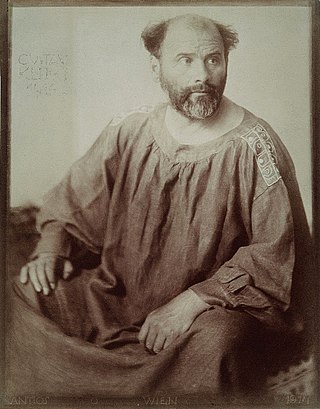
Gustav Klimt was an Austrian symbolist painter and one of the most prominent members of the Vienna Secession movement. Klimt is noted for his paintings, murals, sketches, and other objets d'art. Klimt's primary subject was the female body, and his works are marked by a frank eroticism. Amongst his figurative works, which include allegories and portraits, he painted landscapes. Among the artists of the Vienna Secession, Klimt was the most influenced by Japanese art and its methods.

The Vienna Secession is an art movement, closely related to Art Nouveau, that was formed in 1897 by a group of Austrian painters, graphic artists, sculptors and architects, including Josef Hoffman, Koloman Moser, Otto Wagner and Gustav Klimt. They resigned from the Association of Austrian Artists in protest against its support for more traditional artistic styles. Their most influential architectural work was the Secession exhibitions hall designed by Joseph Maria Olbrich as a venue for expositions of the group. Their official magazine was called Ver Sacrum, which published highly stylised and influential works of graphic art. In 1905 the group itself split, when some of the most prominent members, including Klimt, Wagner, and Hoffmann, resigned in a dispute over priorities, but it continued to function, and still functions today, from its headquarters in the Secession Building. In its current form, the Secession exhibition gallery is independently led and managed by artists.

The Österreichische Galerie Belvedere is a museum housed in the Belvedere palace, in Vienna, Austria.

The Stoclet Palace is a mansion in Brussels, Belgium. It was designed by the Austrian architect Josef Hoffmann for the Belgian financier Adolphe Stoclet. Built between 1905 and 1911 in the Vienna Secession style, it is located at 279–281, avenue de Tervueren/Tervurenlaan, in the Woluwe-Saint-Pierre municipality of Brussels. Considered Hoffman's masterpiece, the residence is one of the 20th century's most refined and luxurious private houses.

Portrait of Adele Bloch-Bauer I is an oil painting on canvas, with gold leaf, by Gustav Klimt, completed between 1903 and 1907. The portrait was commissioned by the sitter's husband, Ferdinand Bloch-Bauer, a Viennese and Jewish banker and sugar producer. The painting was stolen by the Nazis in 1941 and displayed at the Österreichische Galerie Belvedere. The portrait is the final and most fully representative work of Klimt's golden phase. It was the first of two depictions of Adele by Klimt—the second was completed in 1912; these were two of several works by the artist that the family owned.
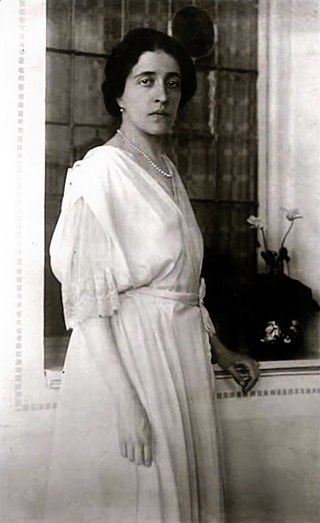
Adele Bloch-Bauer was a Viennese socialite, salon hostess, and patron of the arts from Austria-Hungary. A Jewish woman, she is most well known for being the subject of two of artist Gustav Klimt's paintings: Portrait of Adele Bloch-Bauer I and Portrait of Adele Bloch-Bauer II, and the fate of the paintings during and after the Nazi Holocaust. She has been called "the Austrian Mona Lisa."

The Klimt University of Vienna Ceiling Paintings, also known as the Faculty Paintings, were a series of paintings made by Gustav Klimt for the ceiling of the University of Vienna's Great Hall between the years of 1900–1907. In 1894, Klimt was commissioned to paint the ceiling. Upon presenting his paintings, Philosophy, Medicine and Jurisprudence, Klimt came under attack for 'pornography' and 'perverted excess' in the paintings. None of the paintings would go on display in the university.

The Beethoven Frieze is a painting by Gustav Klimt on display in the Secession Building, Vienna, Austria.
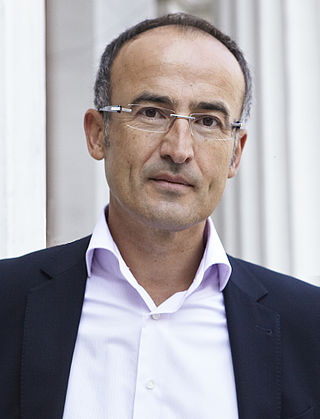
Tobias G. Natter is an Austrian art historian and internationally renowned art expert with a particular expertise in "Vienna 1900".

Emilie Louise Flöge was an Austrian fashion designer and businesswoman. She was the life companion of the painter Gustav Klimt.

Judith and the Head of Holofernes is an oil painting by Gustav Klimt, painted in 1901. It depicts the biblical figure Judith holding the head of Holofernes after beheading him. The beheading and its aftermath have been commonly portrayed in art since the Renaissance, and Klimt himself would paint a second work depicting the subject in 1909.

Death and Life is an oil-on-canvas painting by Austrian painter Gustav Klimt. The painting was started in 1908 and completed in 1915. It depicts an allegorical subject in an Art Nouveau (Modern) style. The painting measures 178 by 198 centimeters and is now housed at the Leopold Museum in Vienna.
Hope I is an oil painting created by Gustav Klimt in 1903. It is 189 cm x 67 cm and currently located in the National Gallery of Canada, Ottawa. The main subject of this work is a pregnant, nude female. She is holding her hands together above her stomach and close to her chest. She gazes directly at the viewer and has a great mass of hair with a crown of forget-me-not flowers placed on her head. The scene is beautiful upon first glance but once the viewer's eyes move to the background, deathlike figures become noticeably present.

The Three Ages of Woman is a painting that was completed in Austria in 1905 by Gustav Klimt, symbolist painter and one of the most prominent members of the Vienna Secession movement.

Leopold Forstner was an artist who was part of the Viennese Secession movement, working in the Jugendstil style, focusing particularly on the mosaic as a form.
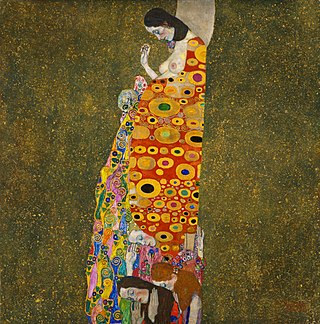
Hope II is an oil-on-canvas painting with added gold and platinum by the Austrian symbolist artist Gustav Klimt, made in 1907–08, depicting a pregnant woman with closed eyes. It was the second of Klimt's works to focus on a pregnant woman, both depicting Herma, one of his favourite models. It was entitled Vision by Klimt, but has become known as Hope II after the earlier work Hope, which is now distinguished as Hope I. Hope II was acquired by the Museum of Modern Art in New York City in 1978.
The Kunstschau Wien 1908 was an art and craft exhibition held from June 1 to November 16, 1908, on the grounds of what became the Wiener Konzerthaus in Vienna, Austria. The show was one of dozens of events and festivities marking the 60th anniversary of the reign of Emperor Franz Joseph I. It was organized by Austrian artist Gustav Klimt and the community of avant-garde artists surrounding him, including most notably Koloman Moser, Alfred Roller, Carl Otto Czeschka, Otto Prutscher, and Josef Hoffmann. Despite organizing the workshop, considered to be a groundbreaking showcase of Viennese modernism, Klimt and his colleagues were not invited to the formal, official, celebrations.

The Duchess of Montesquiou-Fezensac is a 1910 oil portrait by Oskar Kokoschka. In this expressionist work Kokoschka strove to capture the essence of his sitter, a young noblewoman afflicted with tuberculosis, with somber tones and stylized gestures. Among his early portraits, Kokoschka considered the work his most valuable, and as his first work to be acquired by a museum it played a key role in establishing the young artist's reputation. During the Nazi period it was confiscated from the Museum Folkwang in Essen and pilloried in the Degenerate Art exhibition before being auctioned off. It is currently in the collection of the Cincinnati Art Museum.
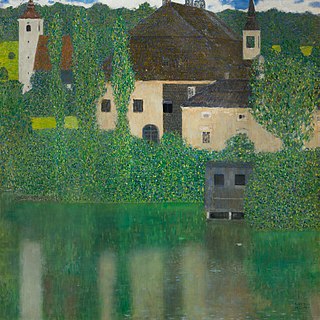
Schloss by the Water or Schloss Kammer on the Attersee I is a 1908 oil on canvas painting by Gustav Klimt now in the National Gallery Prague.




















